
This is a corrected version of the article that appeared in print.
Am Fam Physician. 2019;100(5):281-289
Patient information: See related handouts on treating common colds in adults and treating common colds in children, written by the authors of this article.
Author disclosure: No relevant financial affiliations.
Acute upper respiratory tract infections are extremely common in adults and children, but only a few safe and effective treatments are available. Patients typically present with nasal congestion, rhinorrhea, sore throat, cough, general malaise, and/or low-grade fever. Informing patients about the self-limited nature of the common cold can help manage expectations, limit antibiotic use, and avoid over-the-counter purchases that may not help. Treatments with proven effectiveness for cold symptoms in adults include over-the-counter analgesics, zinc, nasal decongestants with or without antihistamines, and ipratropium for cough. Lower-quality evidence suggests that Lactobacillus casei may be beneficial in older adults. The only established safe and effective treatments for children are acetylcysteine, honey (for children one year and older), nasal saline irrigation, inhaled ipratropium, and topical application of ointment containing camphor, menthol, and eucalyptus oils. Over-the-counter cold medications should not be used in children younger than four years. Counseling patients about the importance of good hand hygiene is the best way to prevent transmission of cold viruses.
Acute upper respiratory tract infection (URI), also called the common cold, is the most common acute illness in the United States and the industrialized world.1 Patients typically present with nasal congestion, rhinorrhea, sore throat, cough, general malaise, and/or low-grade fever. Symptoms are self-limited, often lasting up to 10 days. In children, the median duration is eight days in those who receive medical care, and 90% of cases resolve within 23 days.2 Viruses such as rhinovirus are the predominant cause of acute URI; transmission occurs through contact with the nasal secretions and saliva of infected people.3 The common cold should be distinguished from allergic rhinitis, isolated pharyngitis, acute bronchitis (which generally has a longer duration, with a mean of 18 days in adults and 12 days in children2,4), influenza, bacterial sinusitis, and pertussis (Table 1). The primary goals of treatment are reduction of symptom duration and severity. Over-the-counter cold medications should not be used to treat children younger than four years because of lack of benefit and low but significant mortality rates associated with their use in this population.5,6 Informing patients about the natural course of the common cold can help manage expectations, limit antibiotic use,7 and avoid unnecessary over-the-counter purchases (Table 2).

| Recommendation | Sponsoring organization |
|---|---|
| Antibiotics should not be used for apparent viral respiratory illnesses (sinusitis, pharyngitis, bronchitis). | American Academy of Pediatrics |
| Avoid prescribing antibiotics for upper respiratory infections. | Infectious Diseases Society of America |
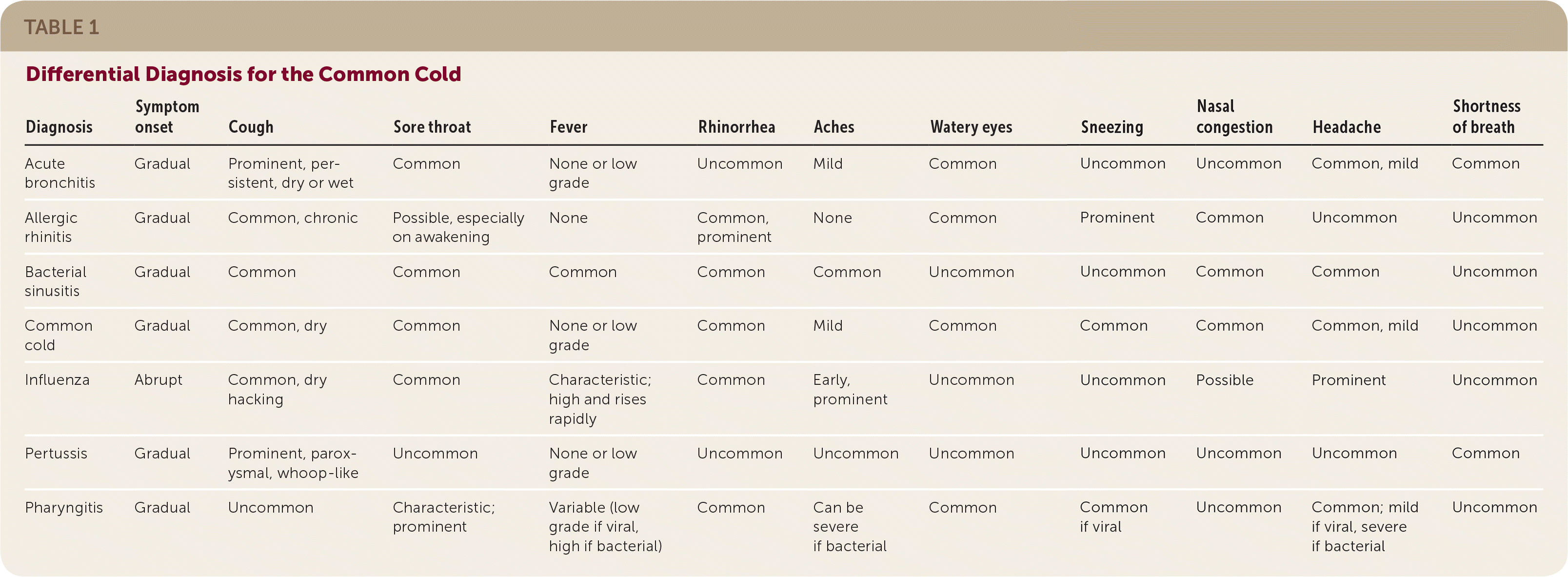
| Diagnosis | Symptom onset | Cough | Sore throat | Fever | Rhinorrhea | Aches | Watery eyes | Sneezing | Nasal congestion | Headache | Shortness of breath |
|---|---|---|---|---|---|---|---|---|---|---|---|
| Acute bronchitis | Gradual | Prominent, persistent, dry or wet | Common | None or low grade | Uncommon | Mild | Common | Uncommon | Uncommon | Common, mild | Common |
| Allergic rhinitis | Gradual | Common, chronic | Possible, especially on awakening | None | Common, prominent | None | Common | Prominent | Common | Uncommon | Uncommon |
| Bacterial sinusitis | Gradual | Common | Common | Common | Common | Common | Uncommon | Uncommon | Common | Common | Uncommon |
| Common cold | Gradual | Common, dry | Common | None or low grade | Common | Mild | Common | Common | Common | Common, mild | Uncommon |
| Influenza | Abrupt | Common, dry hacking | Common | Characteristic; high and rises rapidly | Common | Early, prominent | Uncommon | Uncommon | Possible | Prominent | Uncommon |
| Pertussis | Gradual | Prominent, paroxysmal, whoop-like | Uncommon | None or low grade | Uncommon | Uncommon | Uncommon | Uncommon | Uncommon | Uncommon | Common |
| Pharyngitis | Gradual | Uncommon | Characteristic; prominent | Variable (low grade if viral, high if bacterial) | Common | Can be severe if bacterial | Common | Common if viral | Uncommon | Common; mild if viral, severe if bacterial | Uncommon |
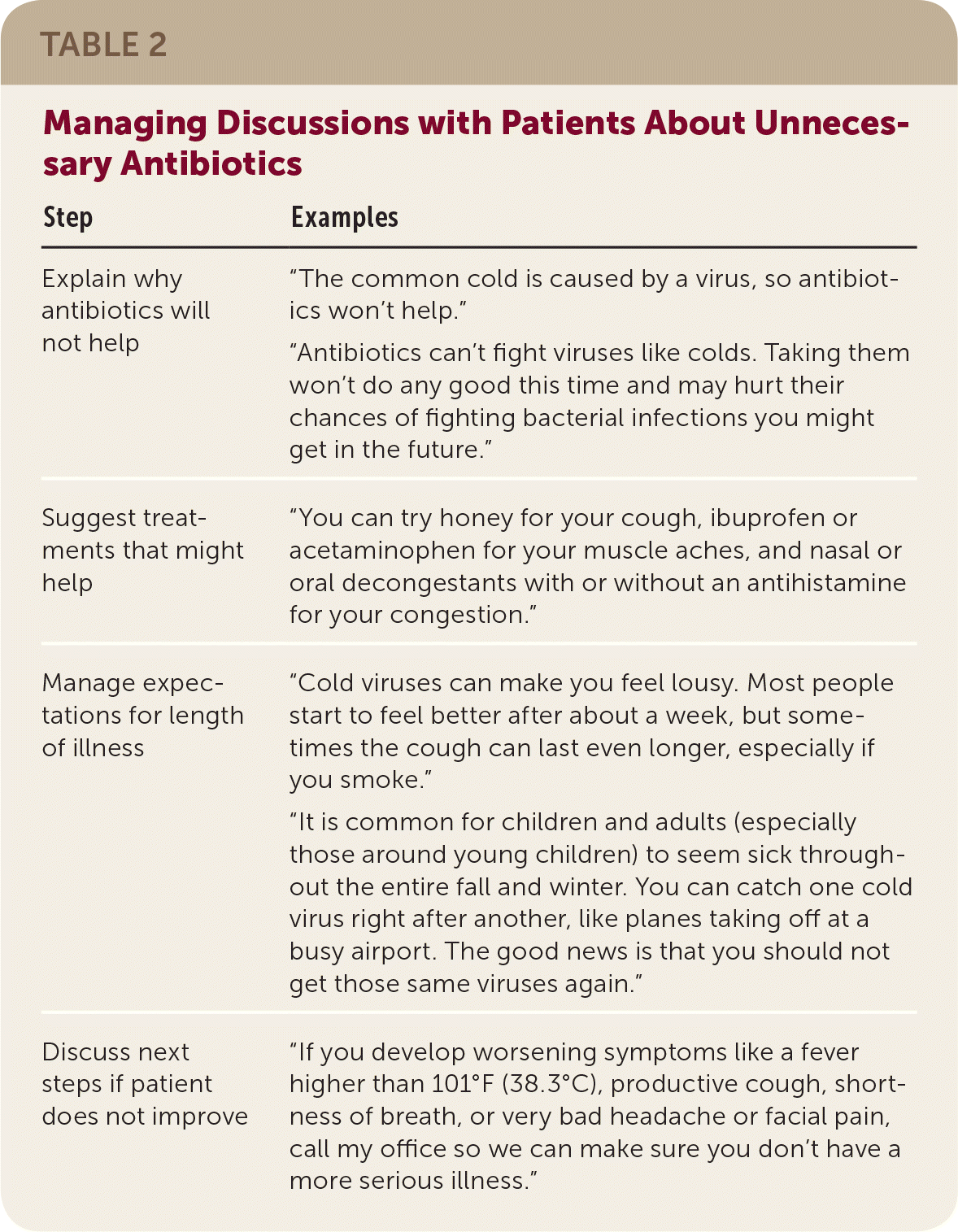
| Step | Examples |
|---|---|
| Explain why antibiotics will not help | “The common cold is caused by a virus, so antibiotics won't help.” |
| “Antibiotics can't fight viruses like colds. Taking them won't do any good this time and may hurt their chances of fighting bacterial infections you might get in the future.” | |
| Suggest treatments that might help | “You can try honey for your cough, ibuprofen or acetaminophen for your muscle aches, and nasal or oral decongestants with or without an antihistamine for your congestion.” |
| Manage expectations for length of illness | “Cold viruses can make you feel lousy. Most people start to feel better after about a week, but sometimes the cough can last even longer, especially if you smoke.” |
| “It is common for children and adults (especially those around young children) to seem sick throughout the entire fall and winter. You can catch one cold virus right after another, like planes taking off at a busy airport. The good news is that you should not get those same viruses again.” | |
| Discuss next steps if patient does not improve | “If you develop worsening symptoms like a fever higher than 101°F (38.3°C), productive cough, shortness of breath, or very bad headache or facial pain, call my office so we can make sure you don't have a more serious illness.” |
Prevention
Good hand hygiene is the most effective and practical way to prevent URIs in children and adults.8 The use of hand sanitizer is more protective than hand washing and is associated with shorter duration of symptoms and fewer school absences.9,10 Washing hands several times per day for at least 15 to 30 seconds can help prevent illness.8,11,12 Regular soap is as effective as antibacterial soap.13
Treatment for Adults
EFFECTIVE SYMPTOMATIC TREATMENTS
| Treatment | Dosing | Duration of treatment | Study findings |
|---|---|---|---|
| Acetaminophen | 500 to 1,000 mg | Single dose | Cochrane review without data pooling of 4 low- to moderate-quality trials with outcome assessment at 3 to 6 hours found improvement in nasal obstruction and rhinorrhea but not in other symptoms; no numeric data provided22 |
| Antihistamine plus decongestant | Varies | Variable | Cochrane review of 12 trials, including 6 placebo controlled with pooled data, found odds ratio of treatment failure = 0.27 (95% CI, 0.15 to 0.50); number needed to treat = 4, but 41% favorable response in placebo group23 |
| Inhaled ipratropium (Atrovent) | 4 20-g puffs 4 times per day | 3 weeks | One small, randomized, double-blind crossover trial (N = 14) found significant reduction in persistent cough24 |
| Intranasal oxymetazoline | 2 sprays (0.05%) per nostril 1 or 2 times per day | Up to 10 days | Cochrane review of 15 trials (N = 1,838) found no improvement in nasal congestion with single use, but small improvement vs. placebo after multiple doses (SMD = 0.49; 95% CI, 0.07 to 0.92)25 |
| Lactobacillus casei (for older adults) | 200 g per day of fermented dairy product containing L. casei | 3 months | RCT of 1,072 older adults found significant improvement in duration of colds and in cumulative days with colds when taken daily26 |
| Nonsteroidal anti-inflammatory drugs | Varies | Varies from single dose to 7 days | Cochrane review of 9 moderate-quality RCTs (N = 1,069) found no effect on total symptom score or cough, but improved sneezing (SMD = −0.44; 95% CI, −0.75 to −0.12), headache (SMD = −0.65; 95% CI, −1.11 to −0.19), and ear, muscle, and joint pain (SMD = −0.40; 95% CI, −0.77 to −0.03) vs. placebo27 |
| Zinc acetate or gluconate | Varies; typically 80 to 92 mg per day | Start within 3 days of symptom onset and continue as long as symptoms persist | 3 systematic reviews and meta-analyses found similar improvement in symptom duration (by about one-third) and mixed conclusions on symptom severity 28–30 |
Analgesics. Nonsteroidal anti-inflammatory drugs—mainly ibuprofen—have been shown to reduce headache, ear pain, muscle pain, joint pain, and sneezing but do not improve cough, cold duration, or total symptom score.27 Ibuprofen is more effective than acetaminophen for reducing fever-related discomfort.31 Acetaminophen may provide short-term relief of rhinorrhea and nasal obstruction but has no effect on sore throat, malaise, sneezing, or cough.22
Decongestants. Nasal decongestants (oral and intranasal) may relieve nasal congestion,25 but there is no evidence that they reduce cough. Topical oxymetazoline, which is included in many over-the-counter intranasal decongestants, reduces the duration and severity of nasal congestion after multiple doses.32 Patients should be warned about the risk of rhinitis when intranasal oxymetazoline is used for more than three days.33
Antihistamines in Combination Medications. Antihistamines combined with oral decongestants and/or analgesics may provide some relief of cold symptoms, although the effect on cough is limited.6,23 This benefit is most pronounced in the first two days of treatment.34 When started on the first day of symptoms, medications containing ibuprofen and pseudoephedrine may reduce the severity of cold symptoms.35 Antihistamine monotherapy is not effective for relieving cough.6,23
Complementary and Alternative Treatments. Several meta-analyses and a randomized controlled trial suggest that taking at least 75 mg of zinc acetate or gluconate lozenges per day relieves cough and nasal discharge more quickly when treatment is started within 24 hours of symptom onset.28–30,38 Probiotics may have a role in the treatment of URIs. A randomized controlled trial showed that three months of daily use of a fermented dairy product containing Lactobacillus casei reduced the duration of URI symptoms by 1.5 days in older adults.26
TREATMENTS WITH UNCERTAIN BENEFIT
Although nasal saline irrigation is effective for the treatment of chronic rhinosinusitis, only low-quality evidence supports its benefit in URIs.39 Increased fluid intake is commonly recommended, but low-quality data suggest that it may not provide benefit and in rare cases can cause hyponatremia.40 Good evidence is similarly lacking for acetylcysteine,41 garlic,42,43 and Chinese medicinal herbs.44,45
INEFFECTIVE TREATMENTS
There are more ineffective treatments for the common cold than effective treatments, and some may even be harmful (Table 4).6,16,19,34,46–54 Treatments that are not recommended include antibiotics, antivirals, most cough medications, antihistamine monotherapy, intranasal corticosteroids, steam, vitamins D and E, echinacea, and Pelargonium sidoides (African geranium).
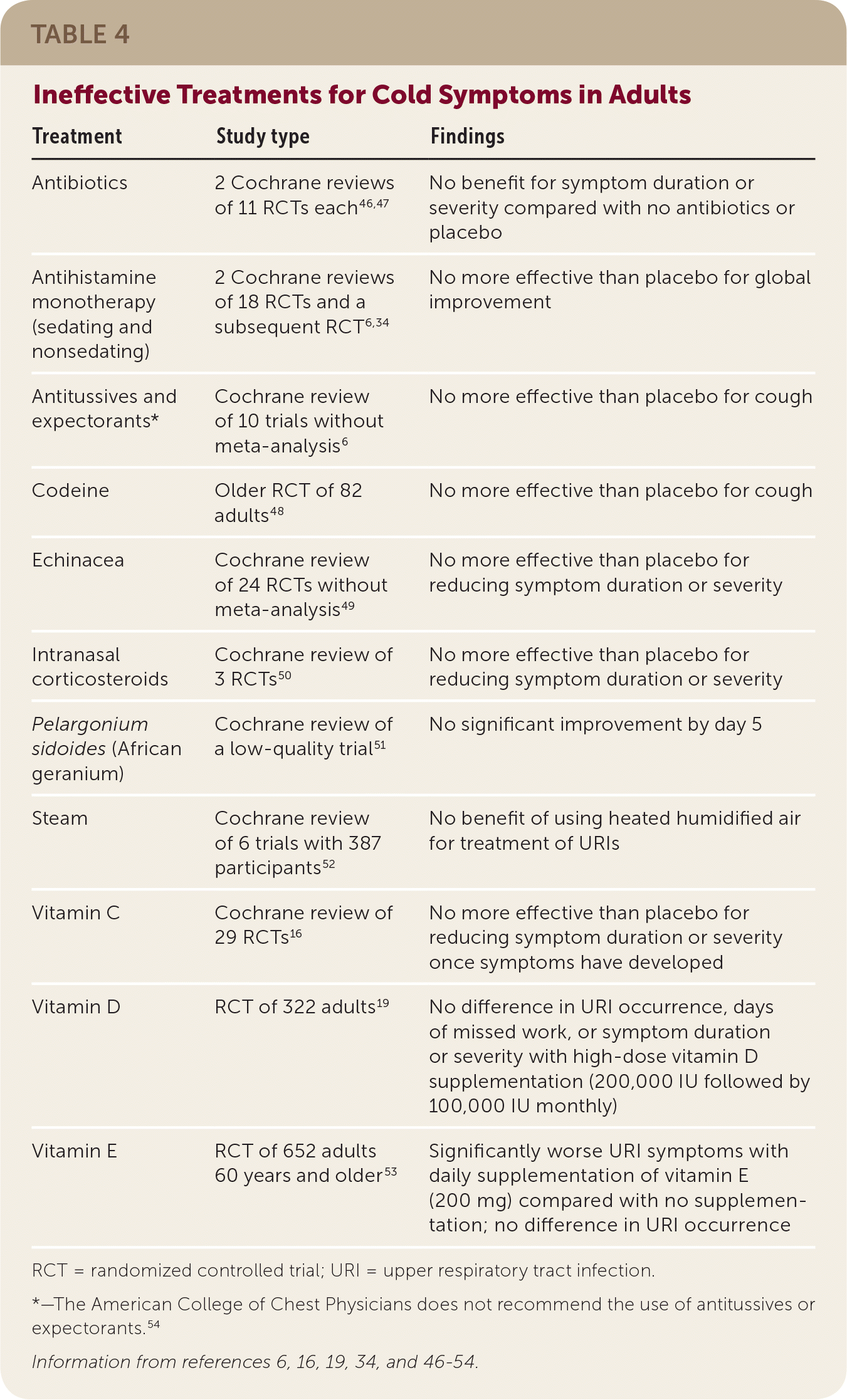
| Treatment | Study type | Findings |
|---|---|---|
| Antibiotics | 2 Cochrane reviews of 11 RCTs each46,47 | No benefit for symptom duration or severity compared with no antibiotics or placebo |
| Antihistamine monotherapy (sedating and nonsedating) | 2 Cochrane reviews of 18 RCTs and a subsequent RCT6,34 | No more effective than placebo for global improvement |
| Antitussives and expectorants* | Cochrane review of 10 trials without meta-analysis6 | No more effective than placebo for cough |
| Codeine | Older RCT of 82 adults48 | No more effective than placebo for cough |
| Echinacea | Cochrane review of 24 RCTs without meta-analysis49 | No more effective than placebo for reducing symptom duration or severity |
| Intranasal corticosteroids | Cochrane review of 3 RCTs50 | No more effective than placebo for reducing symptom duration or severity |
| Pelargonium sidoides (African geranium) | Cochrane review of a low-quality trial51 | No significant improvement by day 5 |
| Steam | Cochrane review of 6 trials with 387 participants52 | No benefit of using heated humidified air for treatment of URIs |
| Vitamin C | Cochrane review of 29 RCTs16 | No more effective than placebo for reducing symptom duration or severity once symptoms have developed |
| Vitamin D | RCT of 322 adults19 | No difference in URI occurrence, days of missed work, or symptom duration or severity with high-dose vitamin D supplementation (200,000 IU followed by 100,000 IU monthly) |
| Vitamin E | RCT of 652 adults 60 years and older 53 | Significantly worse URI symptoms with daily supplementation of vitamin E (200 mg) compared with no supplementation; no difference in URI occurrence |
Antibiotics. Antibiotics have no role in the treatment of the common cold. They do not reduce the severity or duration of symptoms, even when purulent rhinitis is present.46,47 Antibiotic prescriptions for patients with URI are a major source of inappropriate prescribing in the outpatient setting.55 Informing patients about the natural course of URIs and recommending appropriate treatments will improve antibiotic stewardship in the United States.7
Antitussives and Expectorants. Antitussives and expectorants have little benefit in the treatment of cough due to the common cold.6,54 Codeine and other opioid antitussives have not been studied extensively for the treatment of acute cough in adults.6 One trial of 82 adults found that codeine was no more effective than placebo for cough; however, both groups had significant reductions in cough frequency and severity during the first two days of treatment.48
Antivirals. Antivirals are not indicated or effective for the treatment of URIs, and they have been associated with clinical syndromes similar to the common cold. Because of their effectiveness in preventing other conditions, several antivirals (e.g., interferons, dipyridamole [Persantine], palmitate) have been studied for the treatment of URIs. However, no benefit was found, and none are licensed for this use.
Intranasal Corticosteroids. Three small trials found no evidence that intranasal corticosteroids relieve symptoms of the common cold.50
Complementary and Alternative Treatments. Neither steam31,56 nor vitamin D supplementation 19 improves symptoms of the common cold. Once symptoms have developed, vitamin C has no effect on symptom duration or severity.16 Vitamin E can actually make symptoms worse in older adults.53 Although echinacea was previously thought to provide benefit, high-quality studies have not shown that it reduces the duration or severity of cold symptoms.49,52,57,58 Based on low-quality evidence, P. sidoides does not shorten time to resolution of cold symptoms in adults.51
Children
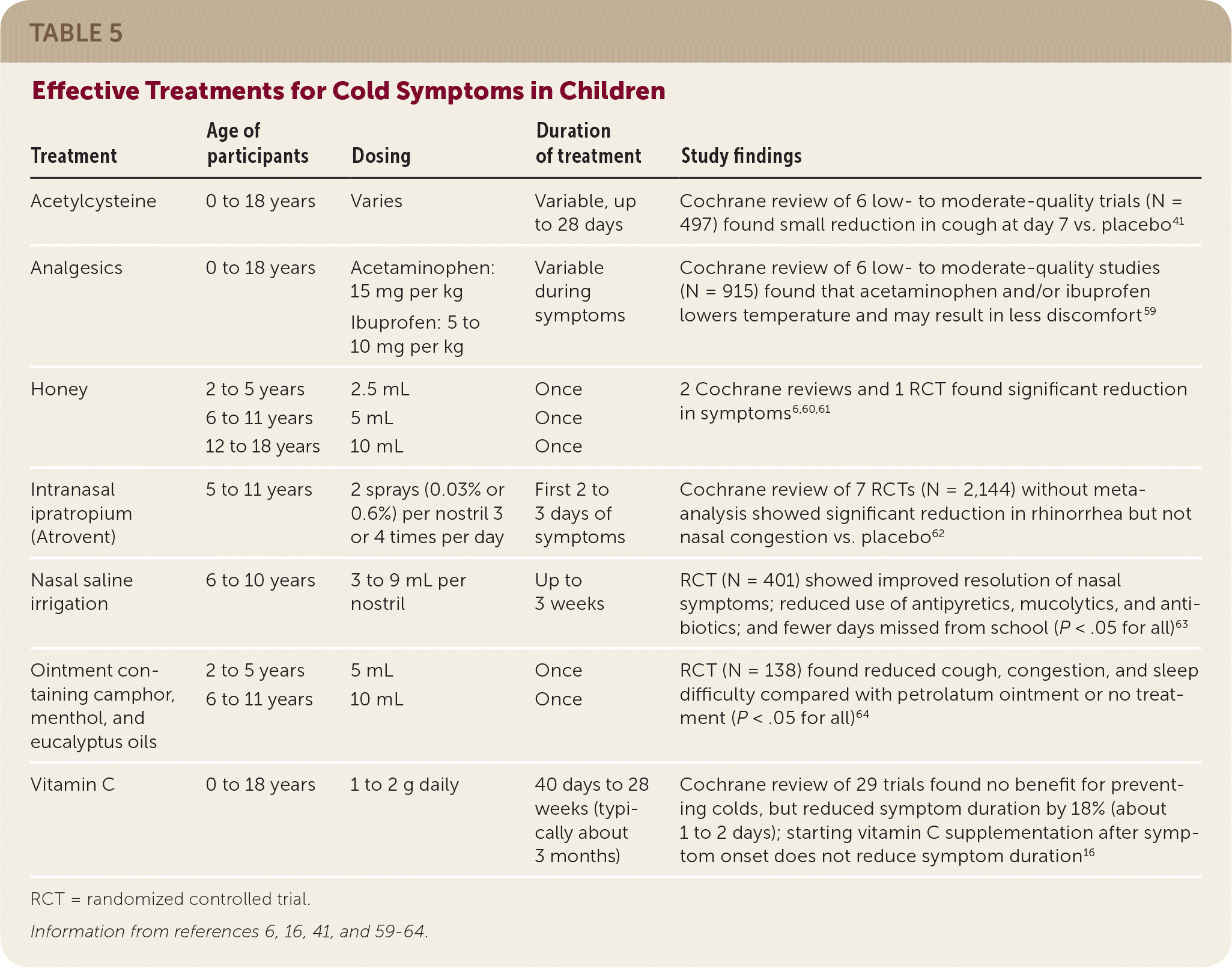
| Treatment | Age of participants | Dosing | Duration of treatment | Study findings |
|---|---|---|---|---|
| Acetylcysteine | 0 to 18 years | Varies | Variable, up to 28 days | Cochrane review of 6 low- to moderate-quality trials (N = 497) found small reduction in cough at day 7 vs. placebo41 |
| Analgesics | 0 to 18 years | Acetaminophen: 15 mg per kg | Variable during symptoms | Cochrane review of 6 low- to moderate-quality studies (N = 915) found that acetaminophen and/or ibuprofen lowers temperature and may result in less discomfort59 |
| Ibuprofen: 5 to 10 mg per kg | ||||
| Honey | 2 to 5 years | 2.5 mL | Once | 2 Cochrane reviews and 1 RCT found significant reduction in symptoms6,60,61 |
| 6 to 11 years | 5 mL | Once | ||
| 12 to 18 years | 10 mL | Once | ||
| Intranasal ipratropium (Atrovent) | 5 to 11 years | 2 sprays (0.03% or 0.6%) per nostril 3 or 4 times per day | First 2 to 3 days of symptoms | Cochrane review of 7 RCTs (N = 2,144) without meta-analysis showed significant reduction in rhinorrhea but not nasal congestion vs. placebo62 |
| Nasal saline irrigation | 6 to 10 years | 3 to 9 mL per nostril | Up to 3 weeks | RCT (N = 401) showed improved resolution of nasal symptoms; reduced use of antipyretics, mucolytics, and antibiotics; and fewer days missed from school (P < .05 for all)63 |
| Ointment containing camphor, menthol, and eucalyptus oils | 2 to 5 years | 5 mL | Once | RCT (N = 138) found reduced cough, congestion, and sleep difficulty compared with petrolatum ointment or no treatment (P < .05 for all)64 |
| 6 to 11 years | 10 mL | Once | ||
| Vitamin C | 0 to 18 years | 1 to 2 g daily | 40 days to 28 weeks (typically about 3 months) | Cochrane review of 29 trials found no benefit for preventing colds, but reduced symptom duration by 18% (about 1 to 2 days); starting vitamin C supplementation after symptom onset does not reduce symptom duration16 |
EFFECTIVE SYMPTOMATIC TREATMENTS
Analgesics. Although ibuprofen and acetaminophen reduce fever-related discomfort, ibuprofen may be more effective.59 Alternating these medications may reduce daycare absences in children with fever.
Acetylcysteine. The mucolytic acetylcysteine may safely decrease cough after six to seven days in children two years and older.41
Ipratropium. Intranasal ipratropium may decrease rhinorrhea but not congestion related to URIs in children five years and older. It should not be used in children younger than five years. The main adverse effects are nosebleeds, nasal dryness, and headache, although these are self-limited.62
Nasal Saline Irrigation. One large trial found that children who use saline nasal washes six times per day have faster resolution of nasal secretions and nasal obstruction and reduced use of antipyretics, decongestants, and antibiotics.63 This regimen also reduces school absences.
Complementary and Alternative Treatments. Application of ointment containing camphor, menthol, and eucalyptus oils on the chest and neck of children at bedtime can relieve nasal congestion and reduce nighttime cough frequency and severity, improving sleep for both the child and parents.64 The use of menthol alone may also improve perceived nasal patency but may not help with cough.65 Menthol is safe for use in children two years and older. The use of honey before bedtime may also reduce the frequency and severity of cough.60,61 Honey should not be given to children younger than 12 months because of the risk of exposure to botulinum spores.
TREATMENTS WITH UNCERTAIN BENEFIT
The use of antihistamines, either alone or in combination with a decongestant, is no more effective than placebo, and the risk of harm is significant.6 There is insufficient evidence on the use of oral or intranasal decongestants as monotherapy for symptoms of the common cold in children.25 Guaifenesin and other expectorants have not been studied in this population. P. sidoides may help with symptoms of acute bronchitis in children, but it has not been studied in children with the common cold.51 Two small trials demonstrated little or no clinically significant benefit of zinc in children, even with frequent doses that were started within 24 hours of symptom onset.66,67 A Cochrane review that previously reported benefit of zinc in children has been withdrawn.68
INEFFECTIVE TREATMENTS
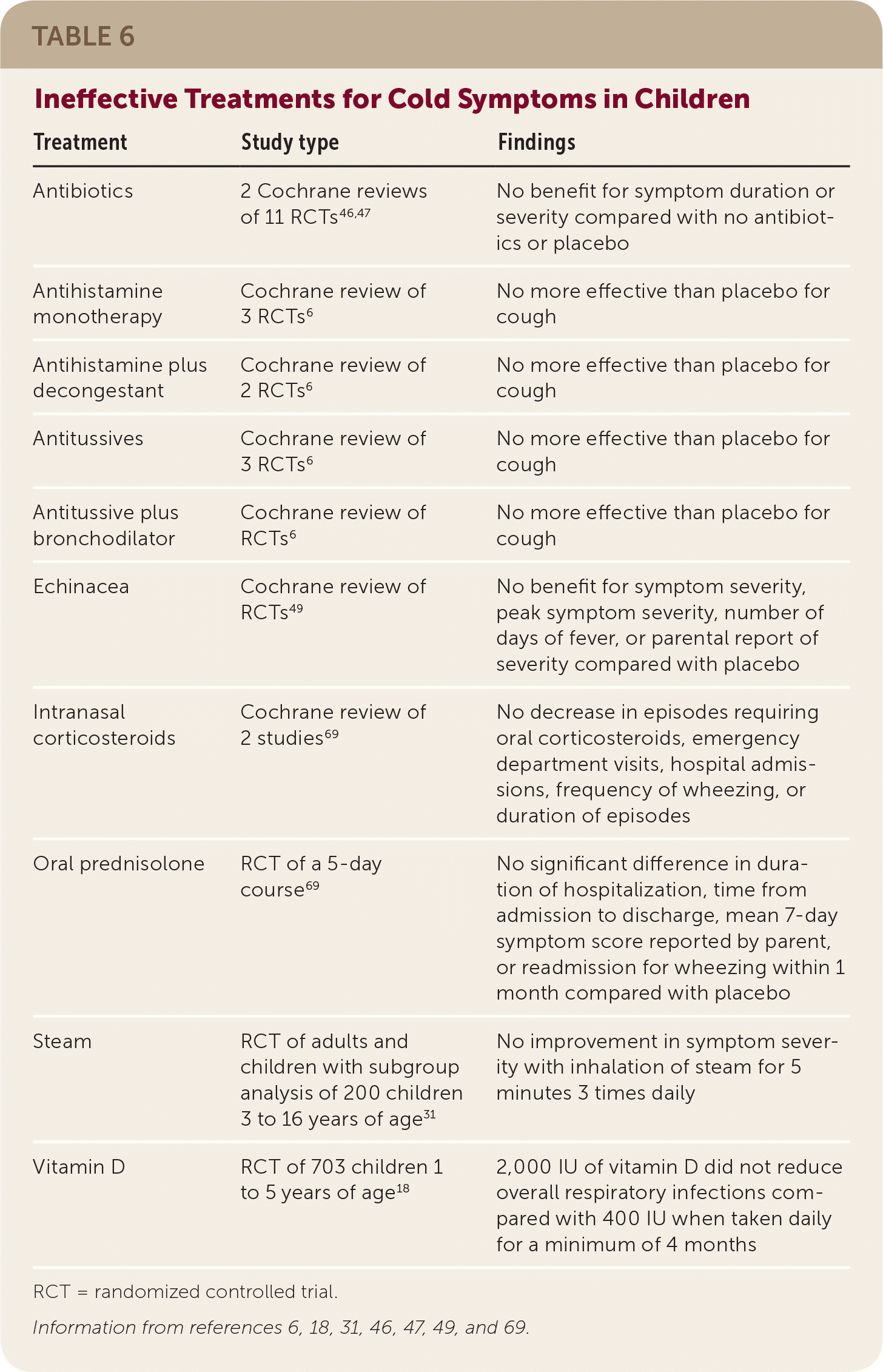
| Treatment | Study type | Findings |
|---|---|---|
| Antibiotics | 2 Cochrane reviews of 11 RCTs46,47 | No benefit for symptom duration or severity compared with no antibiotics or placebo |
| Antihistamine monotherapy | Cochrane review of 3 RCTs6 | No more effective than placebo for cough |
| Antihistamine plus decongestant | Cochrane review of 2 RCTs6 | No more effective than placebo for cough |
| Antitussives | Cochrane review of 3 RCTs6 | No more effective than placebo for cough |
| Antitussive plus bronchodilator | Cochrane review of RCTs6 | No more effective than placebo for cough |
| Echinacea | Cochrane review of RCTs49 | No benefit for symptom severity, peak symptom severity, number of days of fever, or parental report of severity compared with placebo |
| Intranasal corticosteroids | Cochrane review of 2 studies69 | No decrease in episodes requiring oral corticosteroids, emergency department visits, hospital admissions, frequency of wheezing, or duration of episodes |
| Oral prednisolone | RCT of a 5-day course69 | No significant difference in duration of hospitalization, time from admission to discharge, mean 7-day symptom score reported by parent, or readmission for wheezing within 1 month compared with placebo |
| Steam | RCT of adults and children with subgroup analysis of 200 children 3 to 16 years of age31 | No improvement in symptom severity with inhalation of steam for 5 minutes 3 times daily |
| Vitamin D | RCT of 703 children 1 to 5 years of age18 | 2,000 IU of vitamin D did not reduce overall respiratory infections compared with 400 IU when taken daily for a minimum of 4 months |
Bronchodilators. In a randomized controlled trial of 59 children without asthma, oral albuterol did not improve acute cough at seven days compared with placebo, but it was associated with increased adverse effects.72 Beta agonists have no benefit for cough in children without airflow restriction.72,73
Increased Fluid Intake. Low-quality studies suggest that increasing fluid intake in children with URIs actually causes harm.40
This article updates previous articles on this topic by Fashner, et al.,75 and by Simasek and Blandino.76
Data Sources: A primary search of PubMed, the Cochrane database, the TRIP database, clinical guidelines from the American College of Chest Physicians, the National Institute for Health and Clinical Excellence, DynaMed Plus, and Essential Evidence Plus was completed using the key words cold, cough, respiratory tract infection, upper respiratory infection, nasal congestion, and rhinorrhea. We also searched the U.S. Food and Drug Administration website for specific information regarding changes in recommendations for the use of cough and cold medications in children. Search dates: September 5 to November 28, 2018, and February 18 to July 17, 2019.
